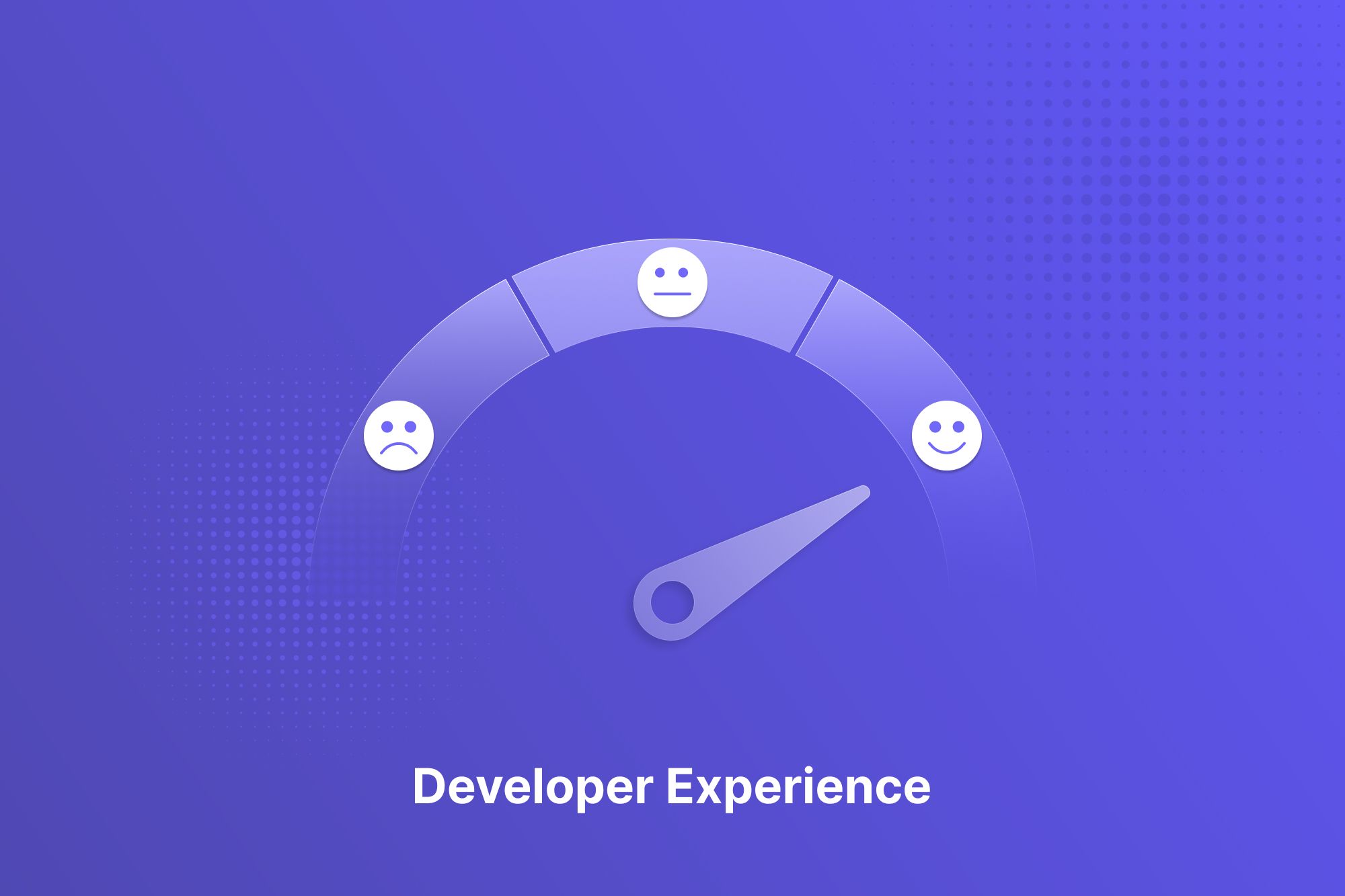Developer experience: What is it and why is it important?

As an engineering leader, there are many things you need to consider while planning the successful delivery of products and features. However, most people forget one crucial element: developer experience (DX). In this article, we’ll cover what developer experience is, its importance, and the metrics that can help you measure it.
What is developer experience (DX)?
Developer experience, or DX for short, defines the overall experience of software developers when they’re using or working on a particular technical product. Simply put, it’s how developers feel when they’re building software.
Most people think DX only covers developers who are creating the product. But that’s not the case. DX also takes into consideration when a developer is using your product (for example, if your end-product users are developers). You can say it’s similar to user experience but with a focus on developers. Just like UX, it’s a combination of positive and negative feelings.
There are two essential elements of DX:
- What developers think of the software development infrastructure, including technical stack (dev tools, programming languages, SDKs, APIs, and libraries) and working processes (general working methods, working agreements, policies, etc.)
- Developers’ feelings about their day-to-day work. Do they feel satisfied? Do they care about the work they’re doing? Do they feel a sense of belonging with their team?
Bad developer experience harms your engineering team (and your organization as a whole). On the other hand, cultivating a positive developer experience ensures your developers are satisfied and stay happy and productive. But before we get to the how, let’s tackle the why.
Why is DX important?
A great developer experience can bring a lot of benefits to your company. Let’s find out what they are:
Better customer experience
When developers have a positive experience, it affects customer experience (CX) in several ways.
Firstly, organizations can ensure faster time-to-market for new features, updates, and bug fixes by incorporating good DX strategies, like intuitive tools, well-documented APIs, and automated workflows. With the necessary tools and a healthy working environment, software engineers can develop and release code quickly. This allows businesses to cater to customers' needs and provide timely improvements swiftly.
Secondly, providing developers with access to well-designed tools and helpful documentation allows them to focus on writing clean, maintainable code. This way, developers tend to produce high-quality software that meets the needs of customers and gives them a smooth user experience, All of this ultimately enhances a customer’s overall satisfaction.
Lastly, implementing DX best practices empowers developers to provide excellent customer support. Developers can quickly identify and resolve issues with access to efficient debugging tools, comprehensive documentation, and a collaborative environment. Timely issue resolution and bug fixes contribute to a positive CX as customers’ concerns are promptly addressed.
Increased productivity
Developers want to do their best work, and creating an environment free of roadblocks empowers them to complete their work efficiently. Organizations can deliver positive DX by providing their developers with clear API documentation, custom tools, and a flexible working environment. Doing so removes common bottlenecks and allows developers to focus on writing code instead of dealing with other issues. This way, developers are more likely to maintain the codebase and speed up the delivery process.
Incorporating other DX practices like automated testing, version control, and rapid feedback also improves your team's code delivery quality (and speed). With access to the best tools, developers can build reliable code and identify bugs faster, ultimately leading to a stable, high-quality end product.
Reduce developer burnout
Burnout is a big problem in the world of software development. According to Forbes, 58% of developers say they currently suffer from burnout. When developers work in a negative environment, it results in low performance and decreases productivity, leading to chronic developer burnout. It could be due to a high workload, no work-life balance, or insufficient resources.
However, engineering leaders can turn this around by taking a developer-first approach and implementing DX strategies like:
- Automating manual tasks
- Practicing internal developer relations
- Simplifying communication
- Working in small batches to allow shorter feedback loops
- Maintaining a healthy work-life balance
- Giving a realistic workload and manageable schedule to developers
- Fostering a culture where developers feel free to experiment and innovate
Adopting these practices goes a long way in creating a positive culture for engineering teams. In addition, engineering managers can get complete visibility into their team’s activities to identify and prevent any signs of burnout.
Higher retention
After dev burnout, retaining engineering talent is the second problem plaguing the industry. As per a report by Stack Overflow, 74% of developers are actively looking for new roles. And no, it’s not just about the money. Frustrated developers tend to quit. The reason could be anything from how their companies treat them to inefficient workflows and inadequate resources.
That’s why keeping your developers happy is the way to retain your engineering talent. Here are some ways you can deliver a positive developer experience to ensure your developers are happy where they are:
- Give them access to high-quality tools; this removes points of frustration and allows them to focus on work they’re actually interested in
- Don’t let them outgrow the job or their skills go to waste; keep providing them with learning opportunities and options for professional growth
- Recognize your engineering teams for their efforts and hard work
- Minimize meetings and allow your developers to spend most of their time on what they’re passionate about, which is building software
- Build reliable automated systems so your developers aren’t stressed about every element of the delivery process
Continuous improvement
Building a pro-dev culture unlocks the innovative side of developers. As engineering leaders, you should create a supportive learning environment that encourages creativity, autonomy, ownership, experimentation, and constructive feedback. Together, these elements enable developers to stay updated, learn from their peers, receive timely feedback, and explore new ideas. This ultimately drives their professional growth and enhances their development practices.
What does good DX look like?
Positive developer experience is all about providing developers with the best tools and environment in their day-to-day work setting. In practice, these factors define great DX:
- Effective and pleasant onboarding
- Intuitive tech stack
- A community for developers to share and learn
- Ability to automate repetitive tasks and deployment processes
- Healthy team culture
- Defined processes for quality analysis, deployment, and feedback
- Writing great documentation like tutorials, how-to guides, technical references, and OpenAPI documentation
- Supporting personal growth
- Reducing wait time and interruptions for devs
- Maintaining a healthy codebase
Moreover, a report by ZenHub mentioned these five ways to increase developer happiness:
- Let developers focus on coding
- Let developers showcase their skills
- Encourage developers to work where they feel most productive
- Promote work-life balance to decrease burnout
- Pay competitive rates to increase retention
Measuring DX with Metrics
Simply implementing a DX strategy isn’t enough; you must also ensure your efforts translate into actual results. You can do so by tracking these metrics that give insights into the general satisfaction and well-being of your developers:
DORA metrics
DORA metrics are the gold standard in the world of software development. Here’s how tracking the four DORA metrics helps organizations deliver a positive developer experience:
- Engineering leaders can use these metrics to identify areas where the software delivery process can be improved. For example, if a team’s lead time for changes is high, it could indicate many manual steps. By automating processes, leaders can significantly reduce the time developers spend on repetitive tasks, thus improving the developer experience.
- Tracking these four metrics helps organizations identify recurring trends and patterns in the software lifecycle. They can use this data to improve their practices continuously.
- DORA metrics provide objective data about a team’s performance. On one hand, this transparency helps developers understand how their work ultimately impacts the end product. Secondly, it also allows organizations to address any challenges faced by developers.
- Tracking DORA metrics also allows organizations to celebrate developers’ milestones. For example, if a team continuously achieves the “elite performers” tag, their leaders can publicly recognize their achievements. Doing so boosts their morale, which reinforces a positive developer experience.
SPACE framework
The SPACE framework captures every element of developer productivity through these five dimensions:
- Satisfaction and well-being: assess how fulfilled developers feel with their work, team, tools, or culture and how healthy and happy they are
- Performance: evaluates the outcome of a system or process, like the impact of a developer’s work on the product’s success or the quality of code
- Activity: measures the quantity of work completed
- Communication and collaboration: how people and teams communicate and work together
- Efficiency and flow: describes the ability to complete work or make progress on it with minimal interruptions or delays
Every engineering org needs great DX. Tracking these five dimensions helps identify which areas of DX your company should focus on to improve developer satisfaction.
Cycle time
Cycle time measures the time from when a developer starts working on a feature to the time of delivery. Longer cycle time may indicate that there are roadblocks in your workflows, which can lead to frustration on the developer’s part.
PR size
Pull request size calculates the average of code changes in a pull request in lines of code or files changed. The size of a PR reflects its complexity. Extremely long PRs may negatively impact the developer experience. There are several reasons why:
- Larger PRs are time-consuming and harder to review. They require extra effort from developers, disrupt their schedule, and take them away from meaningful work.
- Long-standing PRs can be demoralizing for software engineers. They take time to be reviewed, accepted and merged. They also require frequent configurations, which demoralizes developers.
- Large PRs tend to disrupt collaboration among team members. On the contrary, smaller PRs are easier to discuss in detail and offer developers opportunities for feedback and learning.
That’s why engineering leaders can track this metric over time to ensure they’re aiming for smaller PRs.
Merge frequency
Merge frequency calculates the total number of PRs or merge requests a team merges over a specific period. A high merge frequency means your engineering team’s delivery pipeline is robust, and there are few to no bottlenecks, thus creating a positive developer experience. All this contributes to increased satisfaction in your developers.
Final thoughts
Delivering positive DX is crucial for engineering leaders, not only to make developers happy but also to ensure the long-term success of your organization. Having a developer-first approach and improving their workflows, processes, and general working environment is a great way to keep developers satisfied and productive. This way, their day-to-day work becomes easier, and they’re more likely to deliver high-quality code.
If you’re looking to improve your engineering team’s developer experience, then DevDynamics can be a great tool for you. DevDynamics is an engineering analytics platform that offers deep insights into developer satisfaction. Engineering leaders can use our automated reports to find answers about developers’ working patterns, signs of burnout, areas of improvement, and more. In addition, DevDynamics also provides a diverse range of DX metrics that help enhance developer productivity and collaboration.
Ready to drive engineering success?

